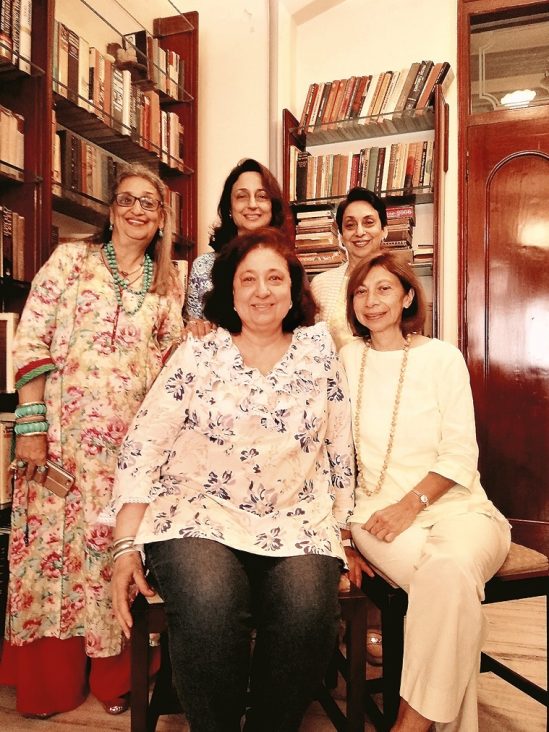A group of old friends has gathered in a cosy room, lined with bookshelves on one side, in a house on Laburnum Road in south Mumbai. “We aren’t rebels or reformists,” says Meher Rafaat, 61, as the others nod in assent. They are five women, all Parsis, who chose to marry for love even if it meant angering the “orthodox” in their community.
Twenty-five years ago, Rafaat, Meher Amersey, Smita Godrej Crishna, Vera Mahajan and Khursheed Narang came together to form the Association of Inter-Married Zoroastrians. The tipping point for them was the death of a young Parsi woman, Roxan Darshan, in an accident. Darshan was a practising Zoroastrian, the daughter of a prominent Parsi family, who had married a Gujarati man under the Special Marriages Act, 1954. “Her body was turned away from the Tower of Silence. A certain section of the Parsi community, including the high priest, said Parsis married to non-Parsis were guilty of adultery,” says Rafaat, who runs an environmental NGO.
An uproar followed, leading the Bombay Parsi Panchayat to consult judges and scholars. “Finally, it was decided that a woman’s body would be allowed to be left at the Tower of Silence if a parent or spouse submits an affidavit that she was a practising Zoroastrian through her life,” says Rafaat, who describes such a condition as a regressive one.
Years later, discrimination against women who choose to marry non-Parsis persists, say the women. Even now, the association helps out inter-faith families by arranging a priest who will agree to carry out a Navjote — the ceremony to initiate a child into the Zoroastrian religion. Many orthodox priests are known to refuse such requests. “But our religion told through the Gathas (songs of the prophet) professed equality of men and women, and enjoined conversion,” says Rafaat, who was married in 1982 to a Bahai man.
She believes that an unfortunate “fundamentalism” is creeping into the religion. “Mumbai is the stronghold and stranglehold of Parsis,” she says. The Bombay Parsi Panchayat, she says, is a “small group which controls the properties and funds and have become the custodians of the religion.” The panchayat denies allegations of gender discrimination. “Our religion is based on gender parity. We have never discriminated against women,” says Noshir Dadrawala, a trustee.
The dwindling numbers of the community have led to an obsession about purity and outsiders, say Rafaat and her friends. According to the 2011 Census, there are 57,264 Parsis in India; an 18 per cent fall from 2001. “In other countries like Sweden and South America, people from other religions are being converted into the Zoroastrian faith on a large scale,” says Crishna, 66, a social worker.
Increasingly, that view has more takers in the community. “Our religion is universal. Only in India has this non-inclusive trend has developed, where we discriminate against those who choose inter-faith marriage. With the number of people in the community already dwindling, the situation worsens if we exclude children of inter-faith couples,” said Vispy Wadia, who formed the Association for Revival of Zoroastrianism in 2006.
Does a Parsi woman who marries outside her community remain a Parsi? Can the custodians of the community ask her to cede her rights — of entering the fire temple (agiyari) or the Tower of Silence — once she has made that choice? The questions assume importance with the Supreme Court recently referring a case filed by Goolrookh Gupta, 52, to a larger Constitution bench. The Mumbai-based woman had moved the Supreme Court in 2013 asking that she be allowed to be present at her parents’ last rites, when that eventuality arose. Goolrookh married a Punjabi Hindu man in 1991 under the provisions of the Special Marriage Act.
She recalls the distress of her friend, similarly married to a non-Parsi, who had been barred from attending her mother’s funeral in Walsad, Gujarat in 2003. It had prompted her to think of what might happen when her parents passed away. “My friend could not attend her mother’s last rites, which I felt was inhuman. She was literally thrown out of the Tower of Silence,” says Goolrookh, when we meet her at her home in a super-luxury housing society in Mumbai’s Mahalaxmi area. She says that she was only able to take up the case owing to the support from her family and the financial backing she has. Her sister, Shiraz Patodia, is a solicitor and senior partner in a law firm, who has assisted her in the case. “My parents are in their 80s and live in Walsad. All I can think of is: will I be allowed to attend their last rites?” says Goolrookh.
When she approached the Gujarat High Court in 2008, the court held that Goolrookh Adi Contractor had ceased to be a Parsi once she married Mahipal Gupta. Goolrookh was 17 when she left Gujarat to study at the Sydenham College, Mumbai. “I met my husband in college. We dated for seven-eight years before getting married around 1991,” she says. Their families had no objection to their wedding.
The children and wife of a Parsi man married outside the community are not stopped from entering the place of worship. Why should the same rights not be accorded to the women?” asks Goolrookh.
In 1997, a few days after her wedding, Dilshad Master Kumar visited her home in Bengaluru. While her family was at ease with her decision to marry a Hindu Punjabi man from Delhi, it soon became clear that the community wasn’t. “I had been invited to a wedding and my husband accompanied me. He got a very cold reception there. He was treated like an outsider. A few people didn’t shake his hand when I introduced him to them, others just looked the other way. It was very strange,” recounts Dilshad, 50, who is the director of a travel company in Delhi. “Until that day, it hadn’t occurred to me that marrying outside the community could be a source of conflict,” she says.
Dilshad says she hasn’t faced any discrimination in the Delhi Parsi community, but she was singled out in Bengaluru again. “I was visiting the fire temple with my father, when the head priest physically blocked the entrance. He wouldn’t allow me in. I asked my father if the fight was worth it and he said, ‘Let it go’. I did,” says Dilshad, who has been following the Goolrookh case closely.
“We are considered a progressive community, but on the subject of inter-faith marriage we suddenly become over-religious. The two don’t add up,” says Dilshad, who is the mother of a six-year-old. Her husband, Dilshad says, is a regular at all Delhi Parsi Anjuman functions, including Navroz (the Parsi new year) and that the family is more “spiritual than religious”.
The restrictions around inter-faith marriages vary from region to region, and city to city. “At the Delhi Parsi Anjuman, we encourage Parsi women who have married outside the community and their spouses to become members. Their husbands have all the rights, including to vote and become a part of the committees. But they can’t enter the fire temple, or be laid to rest at the aramgah (graveyard) and they can’t become trustees of the Anjuman. We also encourage children of such couples to get their Navjote ceremonies done and then become a part of the group,” says Dr Niloufer Shroff, a trustee of the Delhi Parsi Anjuman.
Shroff feels that the restrictions and bans on women in other cities boils down to “property and money”. “Some people fear that outsiders will take over their baap-dada’s (ancestral) property. In Delhi, we have no such concerns. All our property has been given on lease by the Delhi government,” she says. “In Gujarat, if a Parsi girl marries a Muslim and converts, she is no longer a Parsi. If she marries a Hindu boy and continues to follow the Parsi religion, then there is no law that bars her,” says Brigadier (retired) Jahangir Anklesaria, president of Parsi Panchayat, Ahmedabad, who has also married outside the community. During the last rites of a family member, while the women can enter the Tower of Silence, they have to leave once the prayers start. They can sit outside the compound if they want to, when the prayers are on.
Journalist Kamal Kapil Gandhi, 43, echoes Dilshad on the Parsi religion being “inherently liberal”. “The religion is about equality. During Gahambar (a Parsi festival), the rich and the poor are known to traditionally sit together on a table and share a meal. Excluding women who choose non-Parsi life partners is deeply hypocritical,” says the mother of two daughters, aged 7 and 14.
Although her marriage to a Hindu Punjabi in 1999 did not ruffle any feathers in the Parsi community in Delhi, Kamal is not sure if that would have been the case in Mumbai and Pune. “I was born and brought up in Bhavnagar in Gujarat and met my husband while studying dentistry in Mangalore,” says Kamal. The couple work as dentists in Delhi and stay in south Delhi’s Vasant Vihar area.
“In Delhi, initially, I did not know any Parsis. One day, while we were stuck in a traffic jam, a Parsi man noticed the Asho Farohar symbol (a symbol of Zoroastrianism) on our car and knocked on our window. He invited us to a function at the Delhi Anjuman, and since then there has been no looking back. The Delhi Parsi Panchayat has accepted my husband, though he can’t enter the fire temple. Not that he wants to either,” says Kamal.
At home, the family celebrates all festivals, including Diwali and Navroze. “The children are getting the best of both the worlds. My elder daughter recently had her Navjote ceremony. No one raised any issues,” she says.
Hoofrish Krishna Murthy, who married Chetan Krishna Murthy in 2001, “hasn’t stopped being a Parsi since her wedding”. Like Kamal, she also had a Navjote ceremony for her nine-year-old daughter, and sends her for classes to the ‘Farohar of Delhi’, where the children learn about Parsi customs and traditions. “We celebrate Navroze. Like in any Parsi home, we put chalk patterns outside our house and there is dhansak for dinner. In fact, there are many inter-faith couples that send their children to the Farohar,” says Hoofrish.
The question of the rights of the children of a woman married to a non-Parsi is also being contested in a case in the Calcutta High Court. Earlier this year, Kolkata-based businesswoman Prochy Mehta had filed an originating summons in the HC after her grandchildren, aged 10 and 7, were denied entry into the only fire temple in the city. Mehta’s daughter is married to a Hindu man. She said her grandchildren used to visit the fire temple earlier, but after a new priest took over the agiyari in 2013, the temple restricted their admission.
Sanaya Dalal, 35, a former journalist who lives in Mumbai, and is married to a half-Parsi man, says, “I am made to feel like a second-class citizen due to the prevailing law. It is a miscarriage of justice that I cannot bring up my child as an ordained member of the Parsi community.”
Jehangir Patel, editor of Parsiana, a magazine on the community published from Mumbai, says, “In all other religions, conversion is encouraged. It is only our religion which keeps people out. In terms of the two cases, the Calcutta HC one is more important as it seeks the rights of children of women married to non-Parsis,” he says.
“It is sad that many of the important reforms in the community have come through court rulings and not from within,” says Mumbai-based Meher Amersey, 73, who angered her parents 40 years ago by marrying a Hindu man.
***
Zarin Mirza smiles when asked about her marriage to Prasad, a Telugu man who lived in Bihar then. Comfortably seated on a bench outside a restaurant in Ahmedabad, where she works as the head chef, Zarin says, “There was always an unspoken rule in the family about not marrying outside the community. My father is the kind of Parsi who goes to the agiyari every day,” says the 31-year-old.
“When we decided to get married, Prasad’s family was onboard, so was my mother, but convincing my father was tough. We belong to a family of priests and that is why it was important to him that we follow the rules of the community,” said Zarin, who met her husband in 2013, while working at a restaurant.
Since her marriage in 2016, Zarin has not entered the fire temple, though she continues to wear her sudreh and kusti (a white vest and holy thread tied around the waist). “There is no written rule that prevents me from entering the fire temple, but it was a decision I had to take to respect my father. I have never really been a religious person but I do miss going to some community functions. At times, I sit outside the temple,” says Zarin, who is popular at her restaurant for whipping up delicious Parsi dishes.
“We are a progressive community. Most Parsi women are well-educated and quite outspoken. So, it is surprising to see women not being assertive when it comes to inter-faith marriages,” says Zarin. With time, she says, her father has warmed up to her husband. “Whenever we go home, I enjoy seeing how my father insists Prasad speak in Gujarati. He likes him now, I think,” she says. Her cousin has married a non-Parsi too.
“No one has dared to stop me from entering the fire temple, and no one can,” says Ismet Khambatta, architect and director of TDW, a store which sells readymade furniture and architectural products in Ahmedabad. Ismet married Dr Bimal Patel, now the director of CEPT University in Ahmedabad, in 1988. She met Patel when they were studying at the university. “Our families never had a problem and we were not too worried about the community’s reaction. We had a very simple wedding under the Special Marriages Act,” recalls the 57-year-old.
“People tend to confuse social and cultural practices with religious prescription. Many practices have changed over the years. Earlier, menstruating women were not allowed to enter the kitchen or a sacred place. But times have changed, and no one follows these rules anymore. It should be the same for inter-faith marriages,” she says.
Ismet says she is not exactly a religious person and her children have not been initiated into the faith through Navjote. “I do not wear the sudreh and kusti regularly either. I go to the fire temple when there is a function or a ritual.” So what does being Parsi mean to her now? “There are many things to hold on to. We are a bunch of good-natured, enterprising people. We are open to other cultures and, I think, the only way we can thrive is by mingling with other communities. For me, my Parsi identity is a personal thing,” says the designer.
Delhi-based Hoofrish, whose husband is a Hindu from Karnataka, could not agree more. “The fact is you will always be who you are, and no amount of restrictions can take that away from you,” she says.
COURTESY: INDIAN EXPRESS




